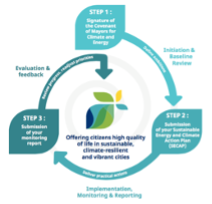 | Covenant reporting and monitoring framework The Covenant reporting and monitoring framework has been developed in consultation with practitioners from local and regional authorities, climate and energy experts and with the methodological support of the European Commission’s Joint Research Centre (JRC). Over the course of 2019, the Covenant framework was aligned with the recommendations of the Global Covenant of Mayors for Climate and Energy (GCoM) Common Reporting Framework. |
Support for developing SECAPs
There are a number of resources to support Covenant signatories in developing their Sustainable Energy and Climate Action Plans (SECAPs).
- The SECAP Guidebook, developed by the JRC, offers signatories a set of methodological principles, procedures and best practices to develop their action plans.
Part 1: The SECAP process, step-by-step towards low-carbon and climate-resilient cities by 2030
Part 2: Baseline Emission Inventory (BEI) and Risk and Vulnerability Assessment (RVA)
- The Covenant FAQs answer some of the most frequently asked questions for developing an action plan
- The Covenant quick reference guides provide ad-hoc information on specific Covenant processes and approaches:
Reporting on MyCovenant
The following resources support signatories using the MyCovenant platform to report and monitor their action plans:
1) Covenant Reporting Guidelines
- The Covenant Reporting Guidelines explain step-by-step how to report in the various sections of MyCovenant.
The Reporting guidelines on energy poverty explain step-by-step the reporting on energy poverty and present the support provided by the Energy Poverty Advisory Hub.
The guidelines are available in all European languages - accessible in the public Library.
The video tutorials below follow the reporting guidelines and demonstrate of MyCovenant (note some new features in the platform may be missing); each video focuses on a reporting section: Strategy, Inventory, RVA, Actions.
The Info-packs provide information on how to: manage the signatory profile, renew commitment, navigate among reporting templates, request delay for reporting, etc. There are info-packs for: i) signatories, ii) coordinators, iii) supporters (available in DE, EN, FR, IT, SP in the public Library).
2) SECAP template (Excel version - working document only)
This SECAP reporting template (Excel version - working document only) is an offline .xlsx template that mirrors the SECAP reporting in MyCovenant.
The template does not contain all the interactive features, automatic calculations and validations carried out in MyCovenant.
The template can be used by signatories as a working document only, to facilitate the preparation of data reporting via MyCovenant – the only official channel to report/monitor data.
See section 3) ‘Import of GHG inventory data from Excel’ on how to import GHG inventory data in MyCovenant from .xlsx.
3) Import of GHG inventory date from Excel
As of the middle of 2023, signatories can automatically import all GHG inventory data (baseline and monitoring data) in MyCovenant using the Excel template ‘GHG emissions’.
Step-by-step instructions on how to import data is available in the template itself and in MyCovenant (within the Reporting corner > ‘Import’).
4) Simplified reporting template (for information only)
In 2023, the Covenant of Mayors – Europe Office, together with partners from the Global Covenant of Mayors, engaged in a simplification of the reporting requirements for Covenant signatories.
This was undertaken in response to requests from signatories around the world to reduce the reporting burden, to accommodate cities with lower capacity and to provide flexibility for advanced cities that may be reporting though other channels, including at the national level.
The Simplified reporting template contains the main Covenant reporting pillars (Strategy, GHG emissions, RVA, Energy poverty assessment, Actions); however, the extent of reported data is reduced. The most significant simplification concerns the GHG emissions inventory.
In Europe, the simplified reporting has been consulted with city practitioners to ensure it is tailored to the EU context.
Simplified reporting will likely be integrated in MyCovenant in 2024. Only then will it be possible for signatories to use the simplified reporting, if they wish to. Up until then, the Simplified reporting template is available for information only.
The future integration of the simplified reporting in MyCovenant will not affect in any way the current reporting carried out by signatories.
For any questions related to reporting on MyCovenant, please contact the Covenant Helpdesk at info@eumayors.eu.
Video tutorials
#1 Strategy | #2 GHG emissions |
#3 Risk and vulnerability assessment | #4 Actions |
Open data policy
By default, all Covenant data is considered “open data”. Signatories reporting through MyCovenant make data publicly available free of charge through the EU Covenant of Mayors website, as well as on the European Union Open Data Portal or the website of the European Commission (e.g. https://ec.europa.eu/jrc/en).
Key data from signatories under the GCoM has been made public through the Global Covenant of Mayors for Climate & Energy website and shared with the UN’s NAZCA platform.
For a baseline emission inventory the import is possible if related template already exists, and thus selecting the option to “overwrite existing emission inventory).
Monitoring emission inventories can be uploaded by creating a new inventory or overwriting an old one (not BEI).
It is strongly suggested to look at the “My inventories” section of MyCovenant reporting corner for errors or missing elements that may have not been visible in the Excel file.
